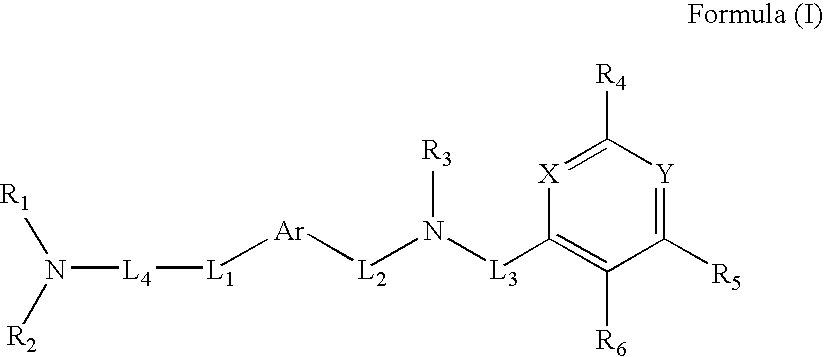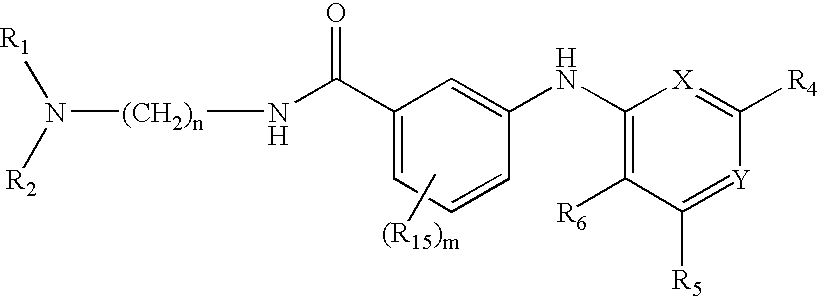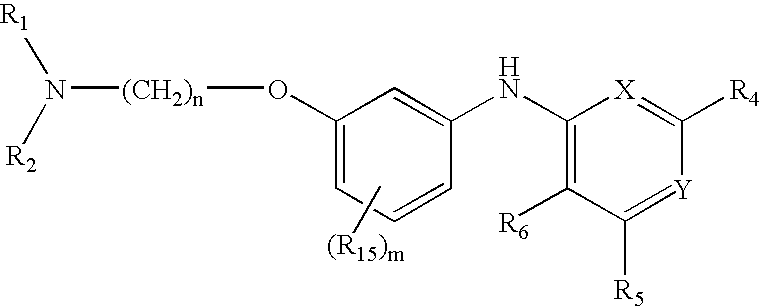Pyridine, pyrimidine, quinoline, quinazoline, and naphthalene urotensin-II receptor antagonists
a technology of urotensin-ii receptor and pyrimidine, which is applied in the field of urotensin-ii receptor antagonists, can solve problems such as pathological consequences and cardiac hemodynamic dysfunction
- Summary
- Abstract
- Description
- Claims
- Application Information
AI Technical Summary
Benefits of technology
Problems solved by technology
Method used
Image
Examples
example 1
N-(2-Dimethylamino-ethyl)-3-(2-methyl-quinolin-4-ylamino)-benzenesulfonamide
Step 1. N-(2-Dimethylamino-ethyl)-3-nitro-benzenesulfonamide (3).
To a solution of 3-nitrobenzenesulfonyl chloride (1, 1.0 g, 4.51 mmol) in anhydrous CH2Cl2 (9.0 mL) was added N,N-dimethyl-ethylenediamine (2, 0.5 mL, 4.55 mmol) dropwise. The resulting solution was stirred at room temperature overnight before it was diluted with EtOAc (80 mL). The organic mixture was washed with saturated NaHCO3 (90 mL), brine (90 mL), and dried over MgSO4. The solids were filtered and the filtrate was concentrated on a rotavap to give 3 as a foam (0.8 g) which was used in the next step without further purification.
Step 2. 3-Amino-N-(2-dimethylamino-ethyl)-benzenesulfonamide (4).
A solution of 3 (0.8 g) in ethanol (10 mL) was subjected to catalytic hydrogenation (10% Pd / C, Degussa, 0.8 g, 3 drops of AcOH, 1 atm.) overnight. To work up, the solids were filtered the filtrate was dried under vacuum to afford 4 as a solid (...
example 2
N-(2-Dimethylamino-ethyl)-3-(2-methyl-quinolin-4-yl-amino)-benzamide
The title compound was synthesized in the same manner as for Example 1 except that 3-nitrobenzoyl chloride was used instead of 1 in Step 1. It was obtained as a pale yellow solid.
example 3
3-(2-Dimethylamino-ethoxy)-4-methyl-phenyl)-(2-methyl-quinolin-4-yl)-amine
Step 1. tert-Butyl(3-hydroxy-4-methyl-phenyl)-carbamate (7).
A solution of 5-amino-2-methylphenol (6, 1.0 g, 8.12 mmol) and di-tert-butyl dicarbonate (1.95 g, 8.93 mmol) in THF (25 mL) was heated under reflux overnight. After cooling to room temperature, the solution was diluted with EtOAc (75 mL) and the resulting mixture was washed with water (70 mL), 1N HCl (2×70 mL) and brine (70 mL). The organic layer was then dried over MgSO4, the solids were filtered, and the filtrate was concentrated under reduced pressure. The desired product 7 was obtained as an oil (2.16 g) and was carried on to the next step without further purification.
Step 2. tert-Butyl(3-(2-dimethylamino-ethoxy)-4-methyl-phenyl)-carbamate (8).
A mixture of 7 (2.16 g, 9.68 mmol), 2-(dimethylamino)-ethyl chloride hydrochloride (1.53 g, 10.6 mmol) and K2CO3 (5.35 g, 3.87 mmol) in DME (28 mL) / H2O (7 mL) was heated under reflux overnight. After...
PUM
 Login to View More
Login to View More Abstract
Description
Claims
Application Information
 Login to View More
Login to View More - R&D
- Intellectual Property
- Life Sciences
- Materials
- Tech Scout
- Unparalleled Data Quality
- Higher Quality Content
- 60% Fewer Hallucinations
Browse by: Latest US Patents, China's latest patents, Technical Efficacy Thesaurus, Application Domain, Technology Topic, Popular Technical Reports.
© 2025 PatSnap. All rights reserved.Legal|Privacy policy|Modern Slavery Act Transparency Statement|Sitemap|About US| Contact US: help@patsnap.com



